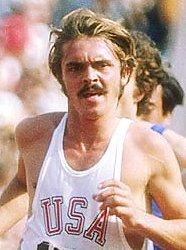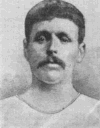
Hey, what the hell is this in my pudding? Oh, yeah... proof.
I'm extremely proud of proud of all of Team Spiridon that were out there giving the race a shot Sunday. Most of us had a great day of PR's and firsts. I know a few of us had mixed to not-at-all mixed feelings about our individual results. Let me tell you - as beautiful as the day was, it was tough. People don't take into consideration the effects of solar heating. Even with the ambient (air) temperature being relatively cool, when the sun is beating down like that, and there's a bit of a breeze, you dry out quickly.
I chatted with some older, experienced marathoners along the way - a couple who have run all 17 Austin Marathons, and a couple of age group leaders. Clearly, they were leading really, really old age groups. They both still passed me. Point is, they all were having a bit of a harder time than expected out there.
For some of us, including me, the race was an abject lesson in pace management. In some races, you can recover from going out a little too fast. Here, the first two and a half miles are uphill - if you're too fast on them, it is going to come back to haunt you.
But let's go through the list:
First among the half marathoners was our last-minute/honorary member for three weeks, Amy Smith. She came in at 2:02:08, a time weirdly consistent with her 3M time of 2:02:02. On a harder course, this is an improvement.
For the Team Spiridon regulars, the first half marathoner was Jacala, a.k.a. "Sandbagger", who came in at 2:28, I think about a 12 minute PR over her 3M time. She has, incidentally, registered for the Nashville Marathon in April, and I'm real confident of her ability to run it.
Carmen has been making a great comeback from the IT band troubles that knocked her out for a few weeks before 3M, where she ran a little over 2:58. She came in with an amazing improvement, at 2:41:52. She should tell all those people who told her she couldn't do something to stick that time somewhere. If she keeps running, she'll break 2:20 at some point, and she is certainly capable of running a marathon, too.
Paul was a little disappointed in how long it took to finish his first half marathon - 3:00:36. Are you f-ing kidding me? You finished, after injuries, DNF'ing 3M and quite a few long runs, and with those clunky-ass looking new shoes. Be proud of what you did. You'll get faster, and you'll end up running the full marathon like you wanted to.
Then there's Debbie - and I mean, holy crap. After a 3:08:24 PR at 3M, she PR'ed again, and beat three hours, with a 2:59:04.
Stacy, we missed ya. Sailing and beer the day before the big race? It's OK, it's another lesson learned, right? At least you got a great race at 3M in.
The marathoners had it a bit rough - no slight at all to the half marathoners, but at about 10 or 11, the sun was doing its thing, and we were feeling it.
Christina was first to come in, at 4:20:32. We stuck together until Lightsey, when I told her she needed to take off. Unfortunately, she really took off, apparently running the next mile at about a minute over her marathon goal pace, and running most of her next 8-10 miles too fast, as well. Obviously, I'm really proud of her, and there's nothing for her to regret. But, it is a lesson in the idea that every second you go out too fast at the beginning of a long race is going to cost you as many as four seconds per mile at the end. Thirty seconds per mile fast becomes as much as an extra two minutes. You all saw from some of our speed workouts the thin line between good fast pace, and leg-toasting pace.
Kellie came in at 4:44:59, a PR over her 4:46:49 from last year. She passed me at the turn from Arroyo Seco onto Romeria, looking as strong as she does on a 10-mile run.
Phillip was close behind, at 4:52:03. I saw him up on White Rock, as I was starting my long, slow death march to the finish. he was walking, but his attitude really assuaged my own disappointment some. He basically just said he was having a rough day of it, but he was going to have as good a time as possible. For the next two or three miles, we'd leapfrog each other as we each alternated walking and running, before he got away from me for good.
Mirsa, who joined our group late, missed the majority of the quality workouts, but otherwise stuck with the schedule and her training, enough to beat out five hours with a 4:56:55. Did I see you pass me, or did I miss you?
Daniel ran his first marathon in several years at 5:01:30. He had passed me with the 4:45 group somewhere around mile 20, I think. The question on everyone's mind of course, is - did he have to stop to poop as he always does?
Eve should not have dawdled in front of the stadium to talk to me - she ran a 5:03:02. Pretty good for the first marathon for someone who didn't think she was going to be able to run a week ago.
Jim finished his tour of Austin, his first marathon in over 10 (20?) years, in 5:33:47. Again, I feel like anyone that was out there for over 4:00 had a pretty difficult time of it. He is not at all the same runner that trained for the half marathon a year ago - he dropped weight, got stronger, managed his injuries well, and his always upbeat and positive attitude just kind of took over, I think.
Then, there's the Twins, Mandy and Jean. With their white caps tufted with pink feathers declaring, "If You're Not Last, You're First", and with training in recent weeks sidelined by illness, injury, work, broken transmissions, and an ill-timed but apparently fun Costa Rican vacation, the two were determined to try to go the distance, by any means necessary, and at any speed necessary.
Mandy's had an intermittent knee pain over the past few weeks, and she was coming off the flu last week. We talked a bit, and I very probably should have more strongly discouraged her from running. Her knee started hurting again in the first few miles. It buckled under her a couple of times, but she still fought all the way through to mile 15 or 16 before stopping and getting medical help. Maybe it wasn't entirely bright, it probably was a result of not the best coaching, but there's no doubt that it shows a lot of guts and sheer will, and she should be proud of what she did. She'll be back. She'll run marathons, and she'll do them well.
At the finish, we waited and waited, not knowing what had happened to Mandy or Jean, but fearing the worst. We finally got a call from Mandy's boyfriend, Paul, filling us in on Mandy's story, and letting us know that Jean had decided to press on.
We waited.
We waited some more.
And then, we continued waiting.
Finally, Christina saw a tall blonde in red shorts and a white cap running smoothly down Congress. Jean finished at 6:28:59, smiling and waving. I am as immensely proud of her as I am of our fastest runners - I had found 5:07 on the course to be incredibly grueling, and I can't imagine being out there for six and a half hours. I once read a quote from a champion female marathoner after running a marathon at a slow pace with an old-timer. She spoke of having a newfound and tremendous respect for the people on the end of the race course opposite from the one she was used to.
There are people who weren't able to be there with us for various reasons -Stacy, Matt, Cassie - but I hope they got something out of their time with us, and I know they're all people who will continue to find ways to challenge themselves, whether it's running or otherwise.
I'm incredibly proud of all of you, and of us as a team. I honestly think we did it better than most. We trained as hard as anyone. We were friendlier on the roads. We volunteered our time. We looked out for each other and respected each other. And in the end, in different ways and different times, we showed what we were made of.
Congratulations to all of you, and I can't wait to see you all at Tiniest Bar on Saturday night.



